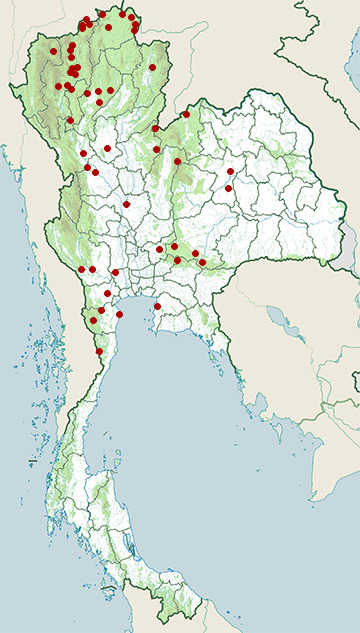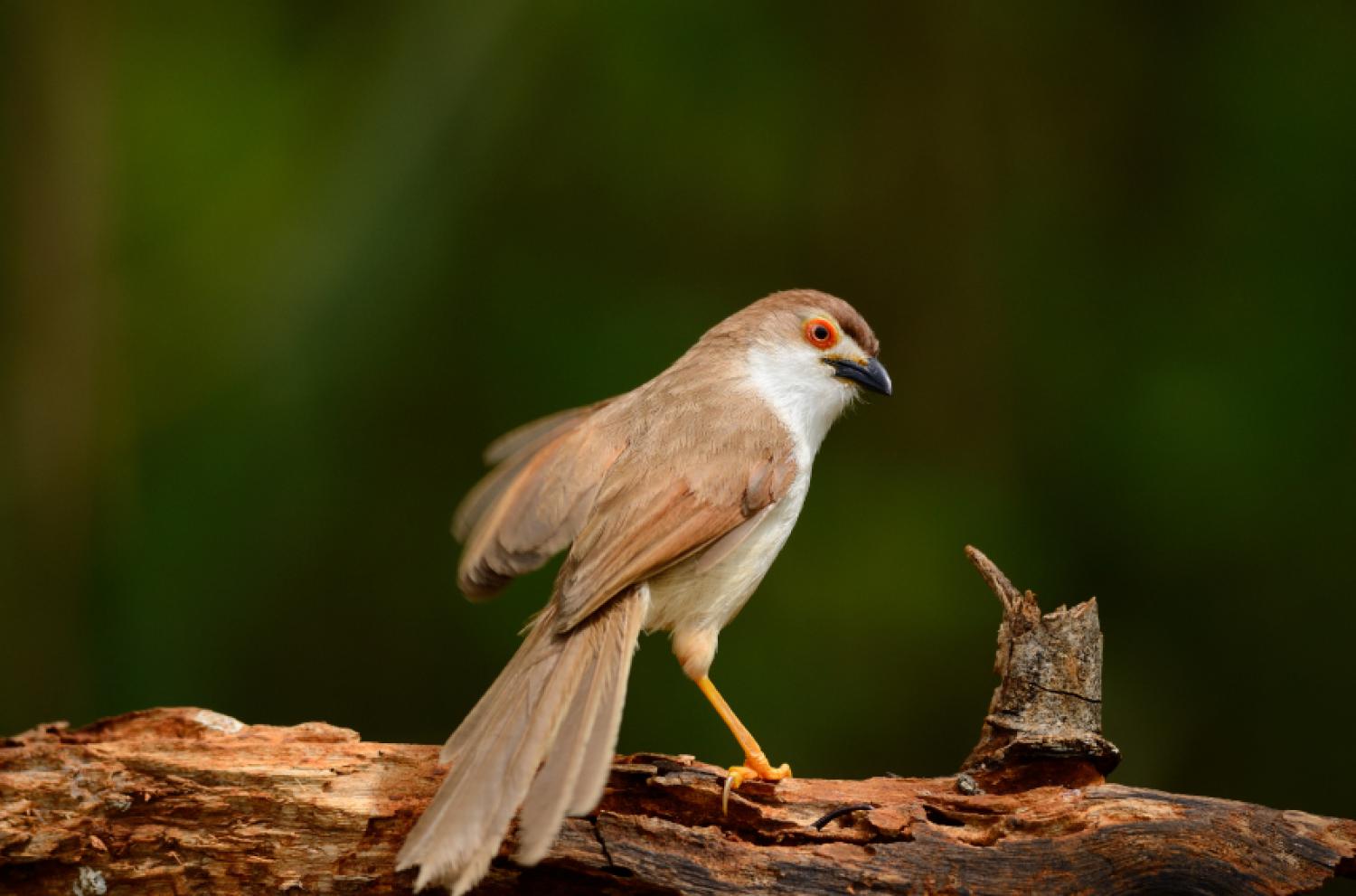Species of Thailand
Yellow-eyed babbler
Chrysomma sinense
Johann Friedrich Gmelin, 1789
In Thai: นกกินแมลงตาเหลือง
The yellow-eyed babbler (Chrysomma sinense) is a passerine bird native to South and Southeast Asia. It inhabits shrubland, grassland and wetland habitats. On the IUCN Red List, it is listed as Least Concern because of its wide distribution and stable population.
Its common name refers to the traditional placement in the Old World babbler family Timaliidae although the genus Chrysomma forms a clade along with the parrotbills within the family Paradoxornithidae.
Description
The yellow-eyed babbler is about 18 cm long with a short bill and a long graduated tail. The body above is brown and the wings are cinnamon coloured. The lores and supercilium are white and the rim of the eye is orange-yellow in adult birds. The beak is black. The underside is whitish buff. The central tail feathers are about twice as long as the outermost. The sexes are indistinguishable in the field.
Within its wide distribution range there are some differences in plumages between populations that have been considered as subspecies. The nominate subspecies is found in Burma, Laos and Thailand. The population in Sri Lanka, nasale, has black nostrils and a stouter bill. The population across much of India, hypoleucum, has yellow nostrils (as with the nominate subspecies) and is paler in plumage. The population in the northeast Duars of India has an almost slaty crown and darker wings and has been called as saturatius or saturatior but this is considered as clinal variation and included in the nominate population.
Distribution and habitat
The range of the yellow-eyed babbler extends from Pakistan through India, Nepal, Sri Lanka to Bangladesh, Myanmar, Thailand, Laos, Viet Nam and China.
The usual habitat is grassy or thorny scrub both in dry and wet regions as well as farmland. It occurs mainly on the plains but also in the lower hills . It is absent in the dense forest region of the Western Ghats and occurs only on the eastern edges or in gaps such as at Palghat.
Behaviour and ecology
Like babblers, these birds are usually seen in small groups of five to fifteen, especially in the non-breeding season. They are usually found inside bushes, emerging up to the top of a stem and then diving back into cover to forage. They feed mainly on insects but take berries (Lantana and Salvadora) as well as nectar. When capturing insects, they may hold them down with their feet. The group constantly produces a series of cheeping or churring calls. During the breeding season, mainly the southwest monsoon (June to August) but sometimes during the receding monsoon, the song is a strong whistling twee-twee-ta-whit-chu, often delivered from a prominent perch. The colour of the inside of the mouth is said to turn from orange-brown to black during the breeding season. They appear to nest cooperatively, the nest being a deep cone made with grass and lined with fine fibre. The nest is wedged between upright stems, the vertical stems being incorporated into the wall of the nest. The outside of the nest is well covered in cobwebs. The usual clutch is four but varies from three to five. The eggs are pinkish white with chestnut-red patches. Both parents take part in incubation and feeding the young. The eggs hatch after about 15–16 days and the young birds fledge after about 13 days. Adult birds have been seen feigning injury presumably to detract predators. Birds roost communally in the centre of a bush, all facing in the same direction and sitting side by side. Members of a group will preen each other. In an apparent territorial display, a pair of birds were found to sing while facing another singing pair and they all simultaneously bobbed their heads while perching on legs held straight to appear tall.
Shikras may sometimes attempt to prey on these birds.
Known in parts of northern India as gulab chashm meaning "yellow spectacles", they were sometimes kept as cagebirds.
This article uses material from Wikipedia released under the Creative Commons Attribution-Share-Alike Licence 3.0. Eventual photos shown in this page may or may not be from Wikipedia, please see the license details for photos in photo by-lines.
Category / Seasonal Status
BCST Category: Recorded in an apparently wild state within the last 50 years
BCST Seasonal status: Resident or presumed resident
Scientific classification
- Kingdom
- Animalia
- Phylum
- Chordata
- Class
- Aves
- Order
- Passeriformes
- Family
- Paradoxornithidae
- Genus
- Chrysomma
- Species
- Chrysomma sinense
Common names
- Thai: นกกินแมลงตาเหลือง
Synonyms
- Pyctorhis sinensis
Conservation status

Least Concern (IUCN3.1)

Near Threatened (ONEP)
Photos
Please help us review the bird photos if wrong ones are used. We can be reached via our contact us page.
Range Map

- Ban Phai District, Khon Kaen
- Bang Phra Non-Hunting Area
- Bueng Boraped Non-Hunting Area
- Chiang Dao District, Chiang Mai
- Chiang Dao Wildlife Sanctuary
- Chiang Khan District, Loei
- Chiang Khong District, Chiang Rai
- Chiang Saen District, Chiang Rai
- Doi Inthanon National Park
- Doi Lang
- Doi Lo District, Chiang Mai
- Doi Pha Hom Pok National Park
- Doi Suthep - Pui National Park
- Fang District, Chiang Mai
- Hang Chat District, Lampang
- Kaeng Khoi District, Saraburi
- Kaeng Krachan National Park
- Kamphaeng Saen District, Nakhon Pathom
- Khao Sanam Prieng Wildlife Sanctuary
- Khao Yai National Park
- Kui Buri National Park
- Laem Pak Bia
- Mae Ai District, Chiang Mai
- Mae Fa Luang District, Chiang Rai
- Mae Mo District, Lampang
- Mae Ping National Park
- Mae Rim District, Chiang Mai
- Mae Taeng District, Chiang Mai
- Mae Tha, Lampang District, Lampang
- Mueang Chiang Mai District, Chiang Mai
- Mueang Chiang Rai District, Chiang Rai
- Mueang Kamphaeng Phet District, Kamphaeng Phet
- Mueang Kanchanaburi District, Kanchanaburi
- Mueang Khon Kaen District, Khon Kaen
- Mueang Lampang District, Lampang
- Mueang Ratchaburi District, Ratchaburi
- Mueang Sukhothai District, Sukhothai
- Mueang Tak District, Tak
- Nam Nao National Park
- Nong Ya Plong District, Phetchaburi
- Pa Sang District, Lamphun
- Pai District, Mae Hong Son
- Pak Chong District, Nakhon Ratchasima
- Phu Chi Fa Forest Park
- Phu Hin Rong Kla National Park
- Phu Suan Sai National Park
- Sai Yok District, Kanchanaburi
- Sakaerat Environmental Research Station
- San Sai District, Chiang Mai
- Tham Sakoen National Park
- Thap Lan National Park
- Wiang Kaen District, Chiang Rai
